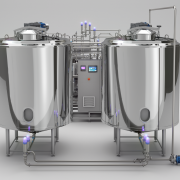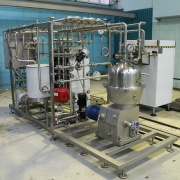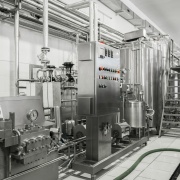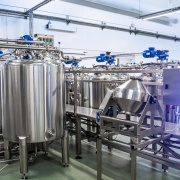Milk reception plants
The main task of this plant is reception, measurement, reservation and storage of milk before further processing.
The design of milk reception plant and equipment selection is directly linked to the capacity of dairy plant.
Every dairy plant has milk reception plant. The main task of it is reception, measurement, reservation and storage of milk before further processing.
If you study milk reception plants at various dairies, you can see that every plant makes something on their own, despite strict rules and requirements for the design of plant.
The design of milk reception plant and equipment selection is directly linked to the capacity of dairy plant.
The milk reception plant should confirm to the following requirements:
- all received milk should be cooled to 4°C;
- the reception process should protect milk against impact of external factors;
- the milk reception should be done as rapidly as possible;
- the measuring of intake should be done in-line;
- connectivity for local or central CIP station;
- automatic control of quantity and quality of received milk and maintenance of data volume.
Generally, the milk reception plant consists of::
- centrifugal pump;
- flowmeter and deaerator;
- dairy filter;
- plate heat exchanger;
- silo tank.
Depending on the need of the customer, the range of milk reception plants with different capacity is possible.
At the big dairies, the milk reception plant may include clarifier and separator for bacteria removal.
At the reception, besides the quantity, the following indicators are defined: temperature, composition, acidity, fat content, content of somatic sells etc.
The reception of milk is as follow, regardless of whether reception is carried out by compact module unit or by single units:
- the milk is pumped from milk tanker;
- cleaning of milk by perforated filter. The clarifier or separator for bacteria removal may be used in case of large volume of milk;
- removal of air from milk by deaerator;
- measuring of quantity of the intake by flowmeter;
- cooling of milk to 4°C by heat exchanger;
- pumping of milk to storage tank.
The capacity of designing and manufacturing milk reception plants is from 1 000 lph to 100 000 lph.
Plava milk reception plants are equipped with equipment of leading international and Russian manufacturers.
Generally the centrifugal pumps are equipped with John Crane mechanical seals and motors with reduced speed, the working part is made from 316Ti steel.
The dairy filters may have a different design. Depending of purpose there are fine and coarse filters, twin filters etc.
Milk cleaners and separators for bacteria removal are delivered in stainless steel version with manual or automatic sludge discharge, the drive of ones may be equipped with frequency converter. The milk reception unit may include milk cleaners for cold milk.
The dissolved air contained in milk cause problems during processing: incrustation of heating surfaces in pasteurizers, reduced skimmimg efficiency in separators, loss of precision when measured in for example automatic standardization or measuring by volume etc. Vacuum deaeration has been used successfully in order to expel dissolved air and finely dispressed bubbles from milk.
Today the milk is measured by volume by means of flowmeters. These devices have relatively small measurement errors, about 0,25% of the total volume. The main advantage is that the reception data is stored in device memory and may be printed or transferred to central control unit.
The cooling of milk before storage is carried out in plate heat exchanger (PHE).
One of the main part of milk reception plant is storage tanks. The plant depending on dairy capacity and design of it may include both silo tanks and horizontal storage tanks. Depending on requirements, the tanks may be equipped with load cells for measuring of feeding milk, agitators with frequency converter, level indicators etc.
The designing of milk reception plant raises questions, of course: what deaerator should be installed, how to connect separator for bacteria removal or milk cleaner etc.






